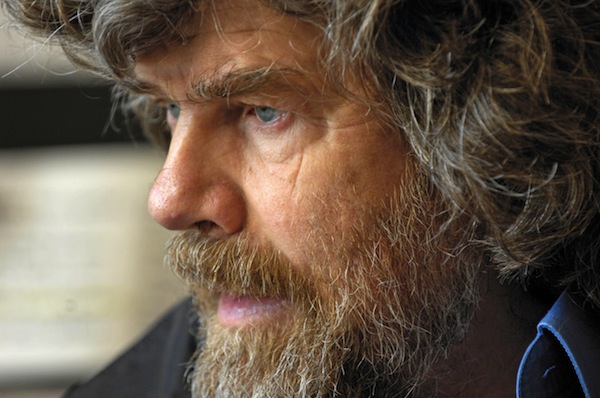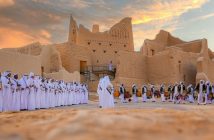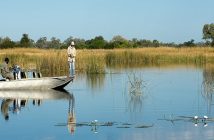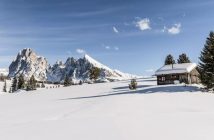The MMM Dolomites, situated at the top of Monte Rite, is the highest of the Messner Mountain Museums and offered the wildest and most spectacular views of them all. It is housed in a converted World War One bunker with long straight passageways thickly walled in stone. Appropriately the theme of the museum is rock and, like Firmian and Ortles, there were many fine paintings illustrating this aspect over the two hundred years of alpinism.
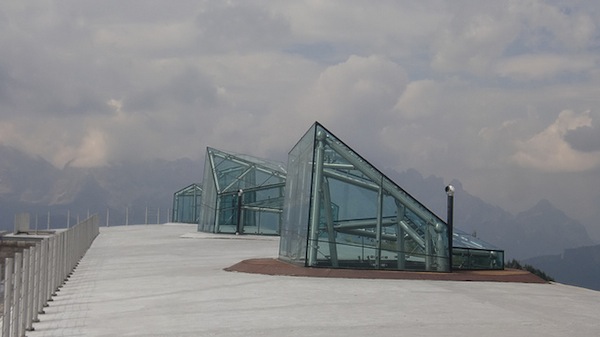
We arrived as the sun was going down. We were in the heart of the Dolomites but at that moment stern black clouds were rolling in from the west. One by one the giants of the range – Monte Schiara, Monte Agnèr, Monte Civetta, Marmolata, Monte Pelmo, Tofana di Rozes, Sorapis, Antelao, Marmarole – were all obliterated by darkness. There were a few huge drops of rain (as if everything was bigger up there) and suddenly a thin finger of lightning flashed dramatically in the distance. There was a crack of thunder and we all hurried indoors as the storm approached.
When we emerged the black clouds had passed and the sky had faded to grey. A thick mist was creeping up from the valleys parting here and there to reveal glimpses of verdant pasture. Heavy white clouds were drifting in from the Heavens, meeting the mist in places to create a wall of impenetrable white. This dizzying curtain was rent as if by an invisible hand and two golden beams from the setting sun lit up five jagged spires of rock like the fingers of a cursing witch.
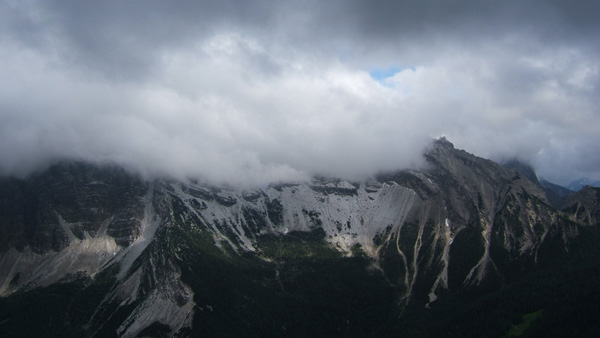
We wandered up to the viewing platform on the summit. The sky was now a kingly purple at its zenith, fading to grey here, blue there. The cloud and mist had rolled away revealing, for a few minutes, the vast and jagged Dolomite range in all its strange splendour. There is something unearthly about them. They are not what one expects mountains to be. They are monumental, but not majestic, resembling teeth and claws, like the open maw of some ancient and slumbering dragon.
And then something else struck me; I felt I was on the roof of the world. Certainly compared to anything we might have in Britain, these were mighty titans. But at two thousand metres, they were barely foothills when stood against the Himalayas. That there were peaks four times this size was difficult enough to conceive, that our host had climbed many of these was almost impossible to imagine.
The old fort also housed a hostel which was to provide our accommodation for the night. The thought of spending the evening crammed head to toe with ten or fifteen other men was not altogether pleasing, particularly when compared to the opulence of the various hotels in which we had lodged, but a spirit of boy scout solidarity prevailed. As usually seems to happen in these things, I wandered in last and got the worst bunk.
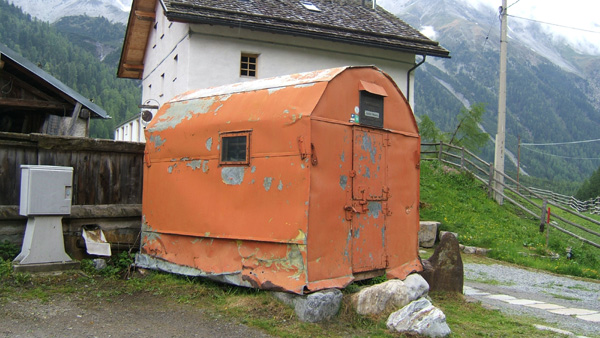
It was our last night and perhaps because of this, and the roughshod nature of our surroundings, people seemed more relaxed, more familiar with each other. The tables were close together in the cramped dining room and conversation was loud and boisterous. After supper was over, because there was nothing else to do and nowhere else to go apart from a damp dormitory, most people stayed on.
Previously at meal times, Messner would have occupied a place at a single table and those sitting nearest to him would have been able to converse with him and ply him with questions. Now a curious thing happened. Perhaps sensing that the trip was nearing its end, Messner’s deep bass boomed louder, people stopped talking to each other and turned to hear what he was saying. Chair legs scraped and pretty soon everyone was facing him. Dinner had become a symposium, a question and answer session with the greatest mountaineer on earth.
After having spent four days with the man and read whatever I could lay my hands on, having interviewed him at length and observed him, I still couldn’t quite work Messner out. Perhaps I was foolish to have imagined I would. Still, I couldn’t quite fathom why, in spite of his statement that “I could only repeat myself,” Messner had given up climbing at his very peak. Did Da Vinci burn his brushes when he had finished the Mona Lisa? There was a clue in what his brother Hansjörg said, “After Nanga Parbat the innocent enthusiasm for climbing was gone.”
I think climbing after this point became a means to an end. And what was that end? Acclaim, recognition, justification, a bettering of his father, proof that he was right. Of course, I can only speculate. It is impossible to know the reasons why men do things. These reasons are often lost to ourselves. Too often we pay lip service to the superficial or the obvious and the truth lies tangled and hidden – a psychological morass. What I felt certain of was that there was very little passion for climbing or his other professional pursuits. He was driven, yes, extraordinarily so, but the two are not the same thing. On the contrary, one can even lead to the death of the other.
“This is something I just don’t understand,” observed Arved Fuchs, his partner on the 1990 Antarctic crossing, “this man is known all over the world, he sets up new standards as far as mountaineering goes, he is very successful, probably very wealthy, but he has never made his peace with his success and with himself, and this I think is the tragedy of his life.”
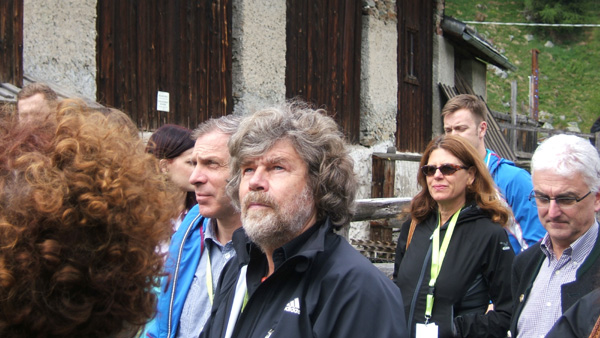
On the day in Ortles when we were halfway up the mountain, I thought I detected something else in Messner. His body was half turned towards the peaks ranged in front of us as though part of him was drawn to the freedom and wildness it represented and the other part was tied down to the practicality of existence which at that moment involved shepherding and fielding questions from a lot of ignorant journalists. His hands, long-fingered and surprisingly feminine, and mobile in gesture, were pointing out all the places he had climbed in his youth. And in his voice and gestures there was the passion of remembrance. In that instant, I thought, he was reliving those precious times. More, he was that boy – that boy who climbed not for money, or prestige, or revenge, but for the sheer thrill and joy of it, climbing because it was in his spirit and blood to do so. Like the ageing Citizen Kane recalling his tatty old toboggan, was this Reinhold Messner’s ‘Rosebud’ moment?
Perhaps passion is difficult to sustain for any of us in anything, be it job or relationship. And when a pastime becomes an occupation, just as when a lover becomes a spouse, perhaps sustaining this passion is one of the greatest challenges of all. In the progress and development of his life, something else manifested itself which was linked or perhaps a consequence of this passion – a certain duality: “Anarchism is essential for alpinism,” he declared in that narrow stone dining room, adding later, “I am an anarchist only in the wilderness”.
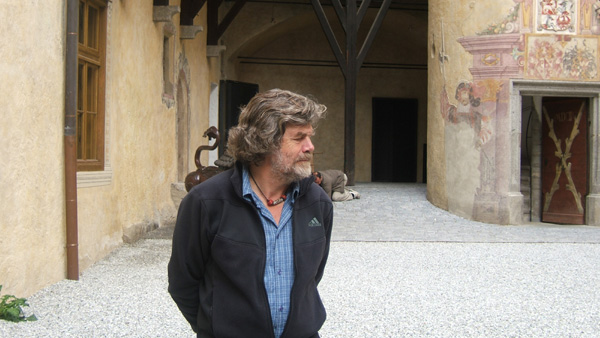
Despite his craggy Ancient Mariner’s visage, it was difficult to square the elderly and well-fed figure before us with his extraordinary achievements in the remote and dangerous places of the world. But perhaps the Messner that donned crampons and down jacket was a different one to the one that rubbed shoulders with mortal men. Maybe we would never get to meet ‘Mountain’ Messner because this mythic figure lived as much in our imaginations as he did seven thousand metres up sheltering in an ice cave with wolves prowling the entrance. Even the image of the baron in his castle was a bit of a ruse. I was disappointed to discover that Messner lived for eleven months of the year in a comfortable apartment in Merano, South Tyrol’s second largest city, together with his second wife and four children (three of whom have grown up).

